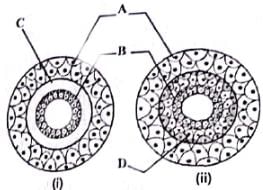NEET Part Test - 5 - NEET MCQ
30 Questions MCQ Test - NEET Part Test - 5
Each photosystem has all the pigments forming light harvesting system also called as:
Thylakoids possessing four types of major complexes have their membranes made up of both proteins and unsaturated lipids. Which of the following complexes is/are evenly distributed in the stroma and granal thylakoids?
a. Photosystem I
b. Photosystem II
c. Cyt b6-f complex
What is true about Nereis, scorpion, cockroach and sliver fish?
Phylum Mollusca can be distinguished from other invertebrates by the presence of
In which of the following, segmentation in the body is first observed?
Among the following organisms which is a completely non-parasitic form?
Read the given statements and select the correct option.
Statement 1: All triploblastic animals are eucoelomates.
Statement 2: They have a false coelom.
Examine the figures of diploblastic (i) and triploblastic (ii) organization in animals given below and identify the labelled parts A to D.

Which reaction in the Calvin cycle is catalysed by the enzyme RuBP carboxylase which results in the formation of two molecules of 3-PGA?
Which one of the following equations suggests that O2 released during photosynthesis comes from water?
Select the correct matching of animals, their symmetry, organisation and coelom type.

Study carefully the given flow chart and fill in the blanks (A), (B), (C), (D) and (E).

Example of artificial auxins are:
(a) IPA
(b) PAA
(c) NAA
(d) 2, 4, 5 - T
(e) 2, 4 - D
Goitre can occur as a consequence of all the following except:
During anaerobic respiration less energy is produced than aerobic respiration because:
In plants, the gaseous exchange take place in:
(a) Stomata
(b) Roots
(c) Stems
(d) Lenticels
Dough kept overnight in warm place becomes soft and spongy due to:




















